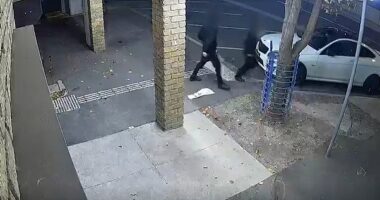Aussie farmers unleash over plans for towering power lines that cut across their land to connect wind and solar projects
- Landholders are divided over the VNI West project
- Proponents say it will provide more reliable power
- Farmers oppose it as towers are built on their land
Towering power lines that cut across farms to connect wind and solar projects to the electricity grid have divided landholders and sparked fierce debate about the shift to renewable energy.
A massive infrastructure project known as the Victoria to NSW Interconnector West – or VNI West – has become a lightning rod.
Proponents claim the poles and wires project would be cheaper, more reliable and less disruptive than any alternatives.
But some farmers fiercely oppose the plans, which would involve towers up to 85m tall on their land.
The project will link wind farms in Victoria’s west to green energy hubs in Bulgana and Kerang before crossing into NSW.

A massive infrastructure project known as the Victoria to NSW Interconnector West – or VNI West has divided landholders (stock image)
It’s been touted as a key pillar in Australia’s shift to green power and would allow more energy to flow between the country’s two biggest states.
Bruce Mountain is a director at research group the Victoria Energy Policy Centre.
In a report co-authored with two other writers, Professor Mountain questioned the financial, social and environmental costs of VNI West.
‘It’s becoming increasingly political, which from our point of view is regrettable,’ he told AAP.
‘The transition to clean energy rapidly is in the national interest and we think doing that in a way that does not impose on landholders and the environment is critically important.’
The report proposed a different project involving existing infrastructure and a separate transmission line in north western Victoria.
The authors claimed it would cost half of VNI West, use smaller towers and eliminate any risk of electricity grid failure.
Prof Mountain has been a staunch critic of VNI West and does not believe there’s a need for an energy ‘super highway’ connecting states.
Merryn York from the Australian Energy Market Operator, which manages national electricity and gas systems and markets, hit back at the report.
She said most concerns had been addressed and many of the figures included in the report were unsubstantiated and unsupported by modelling.
‘This creates ongoing confusion and concern for landholders and communities,’ Ms York said.
She said the research group’s alternative route would require homes to be demolished, threaten power supply to towns during construction and fail to deliver cheaper or more reliable energy.

Some farmers fiercely oppose the plans, which would involve towers up to 85m tall on their land (stock image)

Farmers have staged several rallies against the VNI West route, with a group of 40 gatecrashing an event with Anthony Albanese in Horsham last month
Farmers have staged several rallies against the VNI West route, which would result in hundreds of kilometres of power lines across properties.
A group of 40 farmers swarmed Anthony Albanese when he was opening a water park in Horsham, three-and-a-half hours north-west of Melbourne, last month.
It is understood the farmers gatecrashed the event hoping to speak with the prime minister about the VNI West project.
Protesters reportedly made offensive hand gestures towards Mr Albanese and cheered after he’d left.
The Victorian government has promised to pay landowners $200,000 per square kilometre over 25 years in compensation for the VNI West project.
Tim Buckley, director of the Climate Energy Finance think tank, said reconfiguring the grid would increase reliability.
‘Looking at VNI in isolation ignores the wider strategy and need for grid reliability, decarbonisation and a shift away from fossil fuel commodity volatility,’ Mr Buckley said.
The VNI West project is set to be completed in 2026.
The Victorian energy minister has been contacted for comment.









